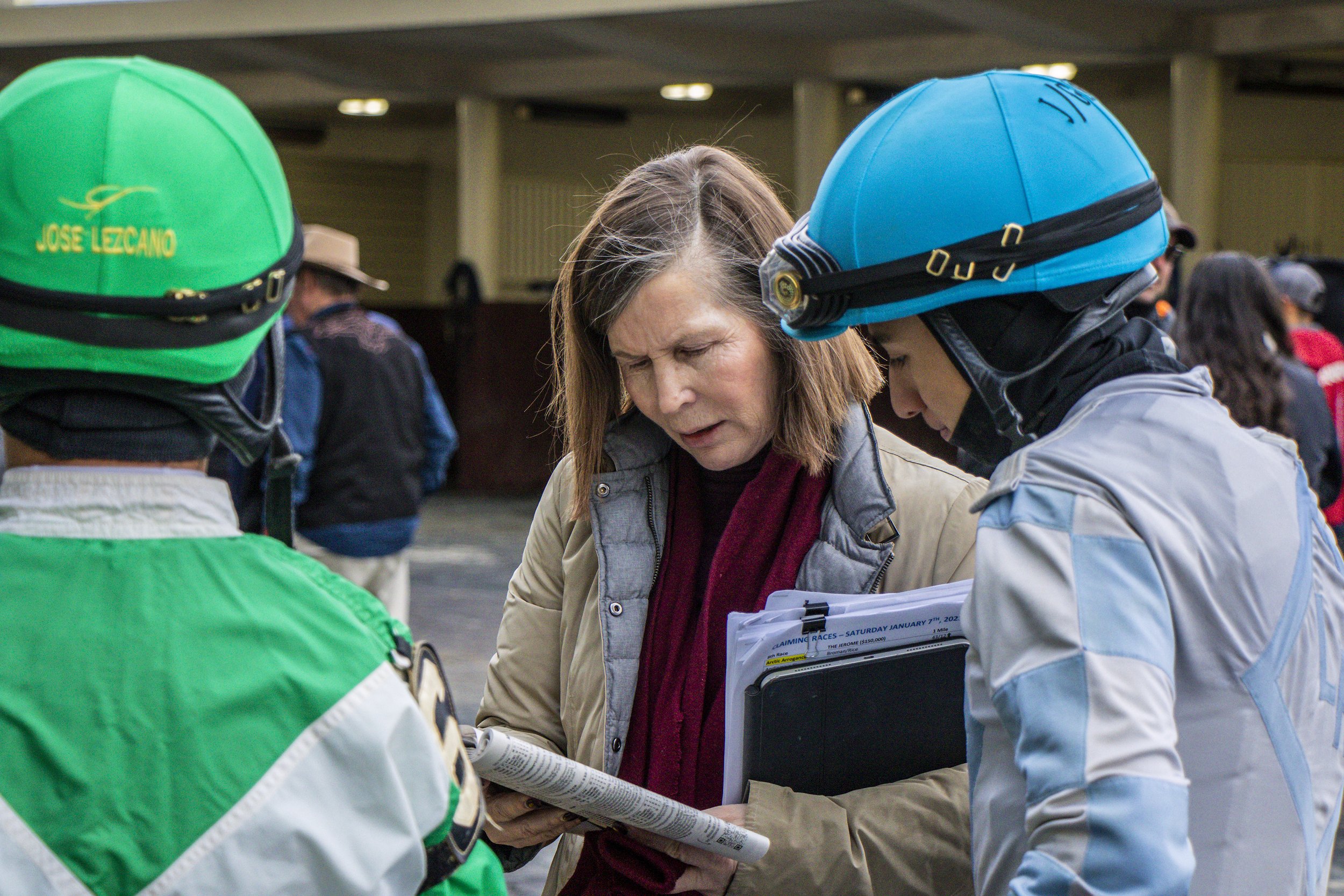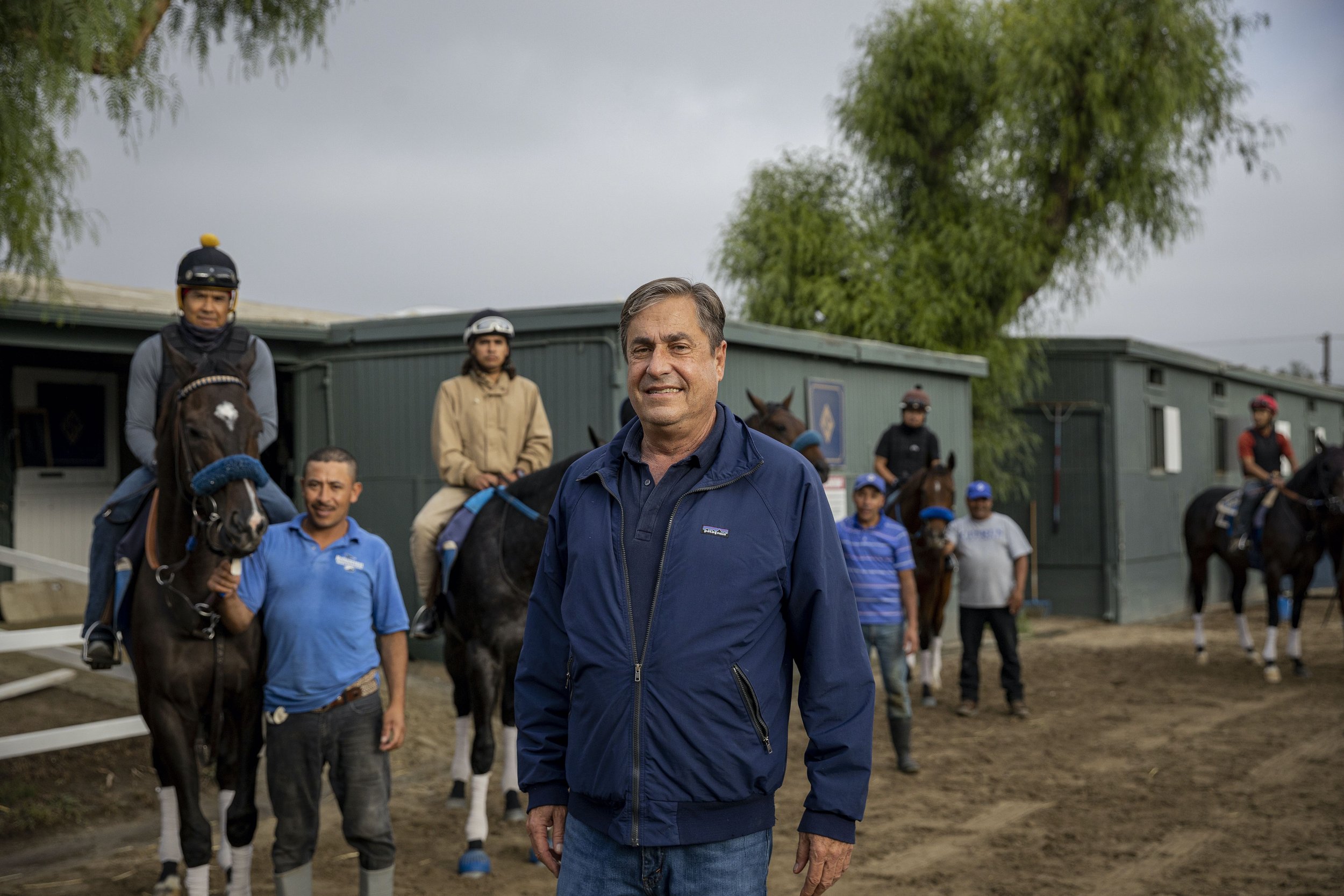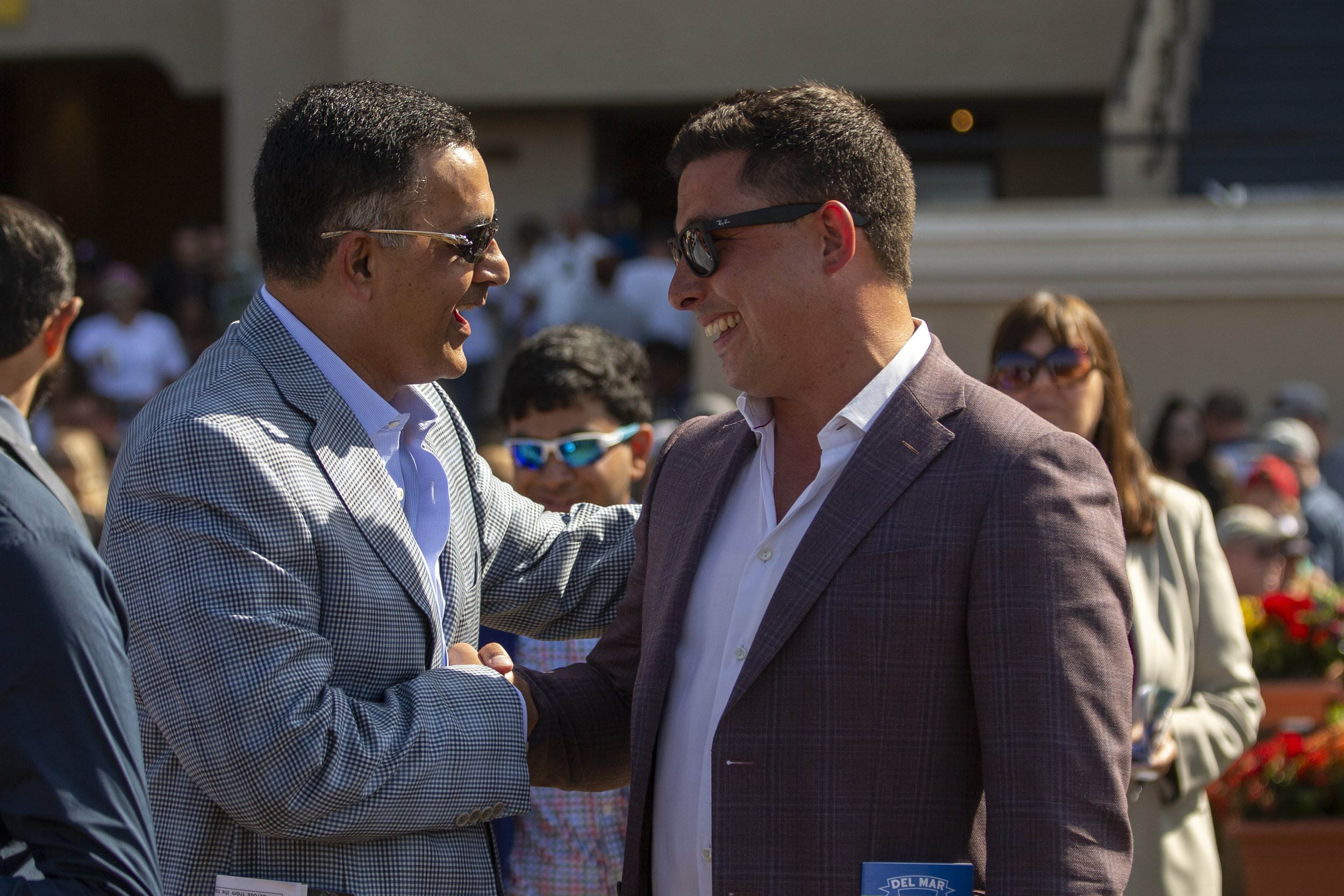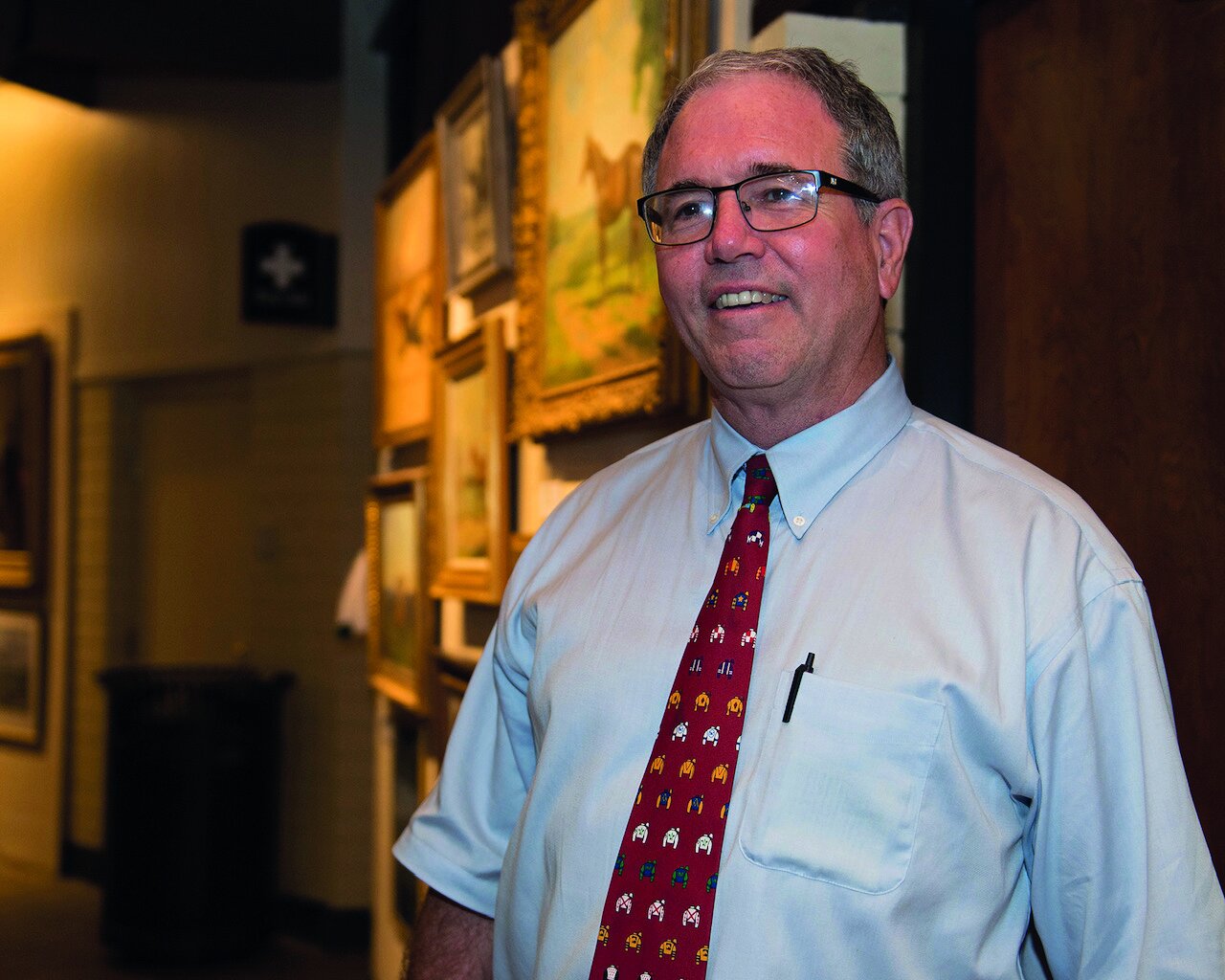#Soundbites - What do you look for when you evaluate a yearling at sales, and are there sire lines that influence your opinions?
Linda Rice
Linda Rice
I look for a good shoulder, and usually that will transcend into a great walk, an athletic walk. I do that for the length of stride. I like to buy young mares. Of course I have preference for some stallions I have had success with like City Zip. And then stallions everybody likes: sons of Into Mischief, sons of Curlin, sons of McLain’s Music. I’ve done well with them. If they have a great shoulder and a great walk, I’ll take a shot on an unproven stallion.
Brad Cox
The first thing, from a physical standpoint, is you have to consider his size. Is he too big or too small? As far as sire lines, you’re looking for signs. You totally have to have an idea what the yearling will look like. Will he look like his sire? You pay attention.
Graham Motion
Graham Motion
I think many of us get influenced by stallions’ progeny that we have trained before. There are other ones that we avoid if we haven’t done well with a sire’s prodigy. I think the one thing I look for is athleticism in general. I’m not overly critical of conformation.
John Sadler
John Sadler
We’re looking primarily for dirt pedigrees for California. I have a good idea what works here, what doesn’t work here. Obviously, I’m partial to some of the sires I trained, Twirling Candy, Accelerate, and Catalina Cruiser who’s off to a very fast start. On the conformation side, I look for a well-conformed horse that looks like an athlete. As an experienced trainer, you look for any little things. You learn what you can live with or without. Then, obviously, I’m looking for Flightlines in a couple of years!
Simon Callaghan
Simon Callaghan
Generally, I’m looking for an athlete first and foremost. Conformation and temperament are two major factors. Yes, there are sire lines I like—not one specific one. Certainly it’s a relatively small group.
Tom Albertrani
Tom Albertrani
I’m not a big sales guy, but when I do go, I like to look at the pedigree first. Then I look for the same things as everyone else. Balance is important. I like to see a horse that’s well-balanced, and I like nicely muscle-toned hindquarters.
Michael Matz
One of the things, first of all, is I look at the overall picture and balance. We always pick apart their faults, then what things that are good for them. You look for the balance, then if they’re a young yearling or an older yearling. Those are some of the things I look at. If you like one, you go ahead. There are certain sires if you have had luck with them before. It all depends on what the yearling looks like. I would say the biggest things I look at are their balance and their attitude. When you see them come out and walk, sometimes I like to touch them around the ear to see how they react to that. That shows if they’re an accepting animal.
Diversification of the Thoroughbred Sire Lines
By Nancy Sexton
From the time the breeding of racehorses became a more commercial pursuit, bloodlines have ebbed and flowed freely across differing racing jurisdictions. The export of various high-profile horses out of Britain to North America during the first half of the 20th century added weight to the development of the American Thoroughbred, giving it a foundation from which to flourish. And when more American-breds came to be imported back into Europe, the British and Irish Thoroughbreds benefitted as well.
All the while, it stands to reason that some sire lines will strengthen and some will die out. Some of those that lose their vigor in one nation might thrive in another. Others will merely be overwhelmed by a more dominant line, as was the case with game-changer Northern Dancer.
A glance at the leading North American sires’ list from 1972 reveals quite how much the Thoroughbred has changed in 50 years. Round Table, Claiborne Farm’s brilliant son of Princequillo, sat at the top with approximately $2 million in earnings ahead of Hamburg Place’s T V Lark, a son of the Nasrullah stallion Indian Hemp. Princequillo and Nasrullah, both of whom stood under Claiborne management, were dominant influences of their day but interestingly each of the top five stallions that year—Herbager, Beau Gar and Count Fleet completed the quintet—represented different sire lines.
Is today’s Thoroughbred a melting pot of fewer viable lines? The 2021 North American champion sires’ table would suggest that might be the case—its top ten containing four male line descendants of Northern Dancer (Into Mischief, Ghostzapper, Paynter and Hard Spun) and four belonging to Mr Prospector (Curlin, Speightstown, Munnings and Twirling Candy).
Of course, given how each surviving branch of Northern Dancer and Mr. Prospector has evolved over time erodes the importance of comparing different representatives; Into Mischief, as a great-grandson of Storm Cat via Harlan’s Holiday, is a very different beast to Awesome Again’s son Ghostzapper as is Curlin to Speightstown and his son Munnings.
Conspicuous by its absence, though, is representation from the once vibrant Hail To Reason line, its most high-profile representative being the veteran More Than Ready in 26th place. Caro’s line is prominent via the deeds of top ten stallion Uncle Mo, although whether that horse can be classed as a typical representative of that line is a moot point. The In Reality sire line, which traces back to Man O’War, remains relevant primarily through Tiznow. However, it doesn’t take too much imagination to envisage it petering out in the near future, much like that belonging to Princequillo, Ribot, Buckpasser and Bull Lea before it.
In Europe, the situation is much the same, dominated by Northern Dancer influences descending from Sadler’s Wells, in particular Galileo, and Danzig, who is at his strongest via Danehill and Green Desert. The outlier at the top end of the market is Mr. Prospector’s great-grandson Dubawi.
Sadly, those lines descending from the likes of Mill Reef, the last British-based champion sire prior to Frankel, Blushing Groom and Sharpen Up today hang by a thread. Others, such as Dante and Habitat, have more or less died out across Europe.
Fiona Craig (right) with Molyglare Stud’s Eva-Maria Bucher-Haefner.
“It has definitely changed,” says Fiona Craig, advisor to the Irish-based Moyglare Stud Farm. “Success breeds success, so to some degree the situation is maybe better because of the dominance of the more successful bloodlines. However, as a result, we may well all lose some of the genetic variation that is so vital for the vigor of a bloodline. It is difficult to fully evaluate at this point as it may take another 50 years to see the effect of the current concentration of bloodlines.”
Duncan Taylor of Taylor Made Sales goes far back into the 20th century, pointing to the success of the Phalaris sire line, and its subsequent concentration, as a catalyst for the current situation.
“From 1956, the leading sire by earnings for each year since tells the story of the Thoroughbred breed and its evolution,” he says. “Speed has been the centerpiece of the story. During this 65-year period, the leading sire list has been topped on only eight occasions by stallions from sire lines other than the Phalaris paternal line. Princequillo (1957 and 1958), Ambiorix (1961), Round Table (1972), Dr. Fager (1977), Nodouble (1980), His Majesty (1982) and Broad Brush (1994) are those eight sires.
“Every other time it has been led by a Phalaris line stallion—Northern Dancer, Mr. Prospector, Bold Ruler and Hail To Reason. If you look back at the leading sires list by earnings for 2021, you see that all bar one of the top 50 stallions traces back to Phalaris: 19 of the 50 trace through Mr. Prospector, 16 through Northern Dancer, 11 through Bold Ruler, two through Hail To Reason and one through Caro. Only the In Reality line, represented through Tiznow [in 45th], does not trace back to Phalaris.”
Taylor adds: “Phalaris was a modest racehorse at stamina distance. As a four-year-old, his trainer [George Lambton] turned to sprint races where he won seven of nine starts and was ultimately crowned England’s Champion Sprinter. As a five-year-old, he became known for his ability to carry more weight than his competitors, doing so with brilliant speed. He went on to become a leading sire of two-year-olds in 1925, 1926 and 1927. He was Champion sire in England in 1925 and 1928.
Duncan Taylor
“What I see in Phalaris and what I have learned about the customers that create the “bullseye market” for buying a yearling in America are very similar. Our horse-buying customers want early two-year-old performers with speed, and they like it when the horse can go on and race at three. They would love for that fast two-year-old to be able to go on and win up to a mile-and-a-quarter at three. Phalaris and his offspring have delivered the speed necessary to put most of the other sire lines out of business. You will still see these other sire lines in pedigrees, but not as the paternal sire line.”
Globalization
Whatever way you look at it, globalization of the business has also been a driving force. On the one hand, it has allowed international breeders access to different bloodlines. On the other hand, it has been a major factor in the commercialism of the industry; once breeding racehorses became big business, fashion gained a new importance.
“The pendulum swings back and forth,” says Dermot Carty, director of sales at Adena Springs in Canada. “For example, one of the biggest influences during the 1930s and 40s was Hyperion. His son Khaled came to America and with success; another son Star Kingdom was successful in Australia; and then Aristophanes stood in South America where he sired Forli, who then came back to stand in Kentucky.
“With the international economics of the 1940s, 50s, 60s, there was a huge movement of horses, mostly back into North America. Then it went the other way—the Sangster group and the Maktoum family were driving forces into sending those bloodlines back to Europe. And all the while, Japan has been importing a lot of bloodlines and with great success—that was obviously how they came to have Sunday Silence.”
Headley Bell of Mill Ridge Farm in Kentucky concurs.
Headley Bell of Mill Ridge Farm, Kentucky
“My grandfather [Hal Price Headley] imported Order out of England and from him bred [champion] Ornament,” he says. “Then he bought Pharamond from Lord Derby and imported him to stand in Kentucky, where he sired champion Menow [sire of champion Tom Fool, in turn the sire of Buckpasser].
“We go through these different phases, and we get these cycles. You look at what John Gaines did at Gainesway, Leslie Combs at Spendthrift and before that Bull Hancock at Claiborne. They tapped into the British Stud Book and reaped the rewards—and that was a long time ago.”
Such cycles have underpinned the development of the breed, initially allowing for more variety. When Never Say Die won the 1954 Epsom Derby under Lester Piggott, he became the first American-bred winner of the race since Iroquois in 1881.
Columnist Frank Jennings, writing at the time in the Thoroughbred Record, noted that: “Never Say Die did a great deal toward changing this thought [that an American-bred would not be able to win the Epsom Derby] and at the same time provided a fine example of the fact that American bloodlines, when properly blended with those of foreign lands, can hold their own in the top company of the world.”
Just over 40 years later, the race boasted a further 11 American-bred winners as well another, Nijinsky, who had been bred in Canada.
“Properly blended” is a key phrase in Jennings’ text, with the industry’s global nature allowing for differing lines to blend in elsewhere to the point that it's not uncommon nowadays for a horse’s background to host European, North American, Japanese and/or Australian-bred names.
“It is important not to underestimate just how much the mare population matters to a stallion,” says Bell, “and how he might blend. We stood Diesis at Mill Ridge Farm—he was a champion two-year-old in Britain by Sharpen Up; and when he came here, he was provided with those American speed mares. And it clicked; it worked for him.”
As Carty notes, Adena Springs’ stalwart Silent Name is another fine advertisement for a Thoroughbred melting pot. One of the first sons of Japanese supersire Sunday Silence to stand outside Japan, the Gr. 2 winner is a proven Gr. 1 stallion and sits perennially among the leading Canadian sires.
“Silent Name was bred in Japan by the Wertheimer brothers from an European pedigree that had heavy doses of North American influences,” he says. “He’s out of a mare by Danehill, and his second dam is by Blushing Groom. You’ve got Raja Baba, a son of Bold Ruler, in there, too. So it’s a really international pedigree.
“To build this kind of family requires the ability to think long term, and it’s a long process. Credit to the Wertheimer brothers as they had the vision and sight to send mares to Japan and tap into these different bloodlines. Credit to the Wildenstein family and Maria Niarchos for doing the same as well.”
Contraction
Are we closing in on a situation where the breed might be contracting too much?
“Any answer will be determined on what you are trying to breed,” says Craig. “A sound racehorse with a turn of foot or successful sales horse? Do you prefer to out-cross bloodlines, or are you happy to concentrate on currently successful bloodlines to meet market fashion and sell well?
“For me, primarily trying to breed racehorses, I find it increasingly restrictive simply because so many of the broodmares are by or out of the current stallions. That is an increasing problem, and I see the same in yearlings at sales.
“We can make statistics to say anything, but what they do show is that speed is essential for a racehorse. But class speed. Sadly we are now in a world where cheap speed sells, and class stamina is overlooked or not wanted at the sales.”
The power of the commercial market is certainly a factor.
As Bell notes, most breeders are in the position of having “to play the commercial card.”
“The reduction of the foal crop is also something that’s at play here,” he says. “When you’re going down from 35,000 foals to 19,000, you’re going to get limitations. So we’re playing with the cards that we’re dealt.”
Away from commercial dictations, the shift can also be attributed to the overwhelming influence of Northern Dancer, a great-great-grandson of Phalaris.
Bred by E.P. Taylor, it is part of racing folklore how the late May-foaled Northern Dancer was shunned by buyers on account of his size as a yearling yet went on to win the Kentucky Derby in record time several weeks short of his actual third birthday.
Northern Dancer was sired by a horse, Nearctic, whose female family had been imported by Taylor out of Britain in the early 1950s. At stud, he wasted little time in transcending the gap between North America and Europe, with the deeds of his second-crop son, 1970 Triple Crown winner Nijinsky, prompting a heightened interest in the stallion that was subsequently justified through the likes of Sadler’s Wells, El Gran Senor, The Minstrel, Secreto, Lyphard and Nureyev.
Today, the breed is awash with Northern Dancer, particularly in Europe.
“You look at the role that Northern Dancer played,” says Bell. “He’s by far the most significant. And we’re now seeing Northern Dancer on Northern Dancer work. Delving further in, Danzig on Danzig is more prevalent and can work. Sadler’s Wells on Sadler’s Wells can also work, as we saw with Enable [who was inbred 3x2 to the stallion].”
The idea of major breeders experimenting by doubling up on bloodlines is nothing new.
Ultimus, an unraced but successful sire bred in 1906 by James Keene, was inbred 2x2 to Domino. In Europe, the breeding empire belonging to Marcel Boussac rested primarily upon the influences of his stallions Asterus, Teddy, Pharis and Tourbillon. Indeed, his 1949 Arc heroine Coronation was inbred 2x2 to Tourbillon.
More recently in Australasia, Danehill has become so powerful that in some cases it is hard to get away from his influence. To date, there are no fewer than 15,400 foals inbred to Danehill worldwide—310 of whom are stakes winners. While the list contains various Australian heavyweights such as Verry Elleegant, Farnan, Alizee and Bivouac, it is also interesting to note the number of Australasian farms who market their stallions as being free of Danehill blood when the opportunities arise.
Yet while history tells us that some people will never hold back from multiplying on lines, surely the concentration of today’s sirelines poses some quandaries for breeders.
While Round Table was the North American champion sire of 1972, his place was taken 10 years later by His Majesty, a son of Ribot. By 1992, Northern Dancer was changing the landscape; Danzig was champion in America while in Europe, Sadler’s Wells was in the midst of a championship run that would come to consist of a record 14 sires’ titles. Sadler’s Wells’ own son El Prado broke through with his own American sires’ championship in 2002, and remains a firm influence today via Kitten’s Joy and Medaglia d’Oro.
At the same time, the faster and more precocious Storm Cat, a grandson of Northern Dancer via Storm Bird, was gaining traction on both sides of the Atlantic that would come to be reflected in the successes of Into Mischief, Giant’s Causeway and Scat Daddy—all of whom remain extremely powerful and commercial forces in 2022.
Meanwhile, the Mr. Prospector sire line flourished, whether it be through the likes of Gone West (sire of Elusive Quality, Zafonic, Speightstown and Mr. Greeley), Forty Niner (sire of Distorted Humor and End Sweep), Smart Strike (sire of Curlin) or Fappiano, who has become an increasingly powerful force via Unbridled and Candy Ride.
The Seattle Slew line has consolidated its place as one of America’s best, notably through A.P. Indy and his son Pulpit, who has been so ably represented in recent years by Tapit.
However, all this has come at the expense of other sire lines. Granted, not all of them possessed the vigor to remain relevant. But others were popular and successful options of their time and merely fell foul of commercial desires.
For instance, would Sunday Silence have been so successful had he stood in Kentucky? As it was, Arthur Hancock of Stone Farm attempted to stand his Kentucky Derby winner but support for the horse—one who had been unsold at $17,000 as a yearling and in possession of a light female pedigree—was underwhelming; and he was sold to Japan, where he became an incredible success. While his blood today saturates the breed in Japan, Kentucky options belonging to his sire Halo are limited.
Other causes include a combination of geography, value and circumstances, says Craig.
Ribot at Darby Dan Farm, 1960
“Horses were at one time mainly bred to be raced by their breeders,” she says. “The public sales market was to dispose of those that were not wanted. Mares also often visited stallions that were local and then with time and travel, they went further afield; and a center such as Newmarket began to develop for breeding as much as racing.
“Walter Haefner [Moyglare Stud Farm founder] was one of the first breeders to ship mares by air to Kentucky. He was very wealthy and loved U.S. racing. He sent two mares from Ireland in 1968, primarily to breed to Sea Bird and Ribot. Irish Lass produced Irish Bird, the dam of Assert and Bikala, to Sea Bird. Another mare, White Paper, produced Gp. 1 winner Carwhite to Caro.”
Craig touches upon the wealth of European runners available in America at that time, with Nureyev, Lyphard, Riverman, Irish River, Blushing Groom, The Minstrel, El Gran Senor, Storm Bird, Sir Ivor and Vaguely Noble, among those to leave a lasting impact alongside Sea Bird, Ribot and Caro.
“Many of the top European stallion prospects were abruptly sent to the U.S. in the 1970s due to fear of equine abortion [prompted by the contagious equine metritis (CEM) outbreak in 1977],” she says.
“Comparing stud fees and yearling values in the 1950s and 60s to those at the end of the 1970s and onward shows a vast change, maybe originating in the U.S. as a result of CEM and the flight of leading stallions from Europe, [which] then migrated quickly back to Europe.
“I will always remember attending a Matchmaker seasons and shares auction in the old Radisson in downtown Kentucky in the late 1980s and watching a Northern Dancer season make $1 million. Big business arrived into breeding and as a result into sales, and as we all know, much of this current industry is dictated by fashion. Traditional owner/breeders continued but increasingly found the associated stud fee and broodmare costs limiting.
“Commercial breeders are guided by fashion, and so stallions have to fit the commercial parameters in order to get enough mares; and currently early success and speed are everything. Proven, fast, good looking and recognizable—that doesn't leave many spots for the tough old stallions doing it the hard way. Would Persian Bold have made a stallion now? Would Broad Brush? Both were more than able to get a higher percentage of top performers than the speedy two-year-old performer that gets three times the number of mares.
“And with increased commerciality and 'fashion' came numbers. Fashion and commercial aspects meant that everyone [wanted] to breed their mares to the same sire or sire line, and others were ignored.”
She adds: “Yes, we need the class stamina lines of Roberto, we need Halo, we need Princequillo and Ribot. But they are not flashy or speedy, and sadly not fashionable. Hence the demand is poor, and so those sire lines fade into history.”
Craig laments the contraction of the Grey Sovereign line: “There was a brilliance to those, also temperament, but they worked on all surfaces and in different countries.” Similarly, she is disappointed to witness the contraction of that belonging to Never Bend, a “line of class and brilliance” that supplied Mill Reef and Riverman.
For Headley Bell, use of the Roberto sire line has yielded great rewards.
“Hail To Reason and his son Roberto is such a powerful line,” he says. “I’ve played Roberto and I used Dynaformer a lot with success—our client Lael Stable bred [Kentucky Derby winner] Barbaro by him. I played Halo, more recently through his grandson Hat Trick, the sire of Win Win Win [a Gr. 1-winning homebred for Live Oak Plantation].
“I was also a big Stop The Music player back in the day, although he was different to most Hail To Reasons; he was typey with more speed.”
Of course, the subject of bloodlines isn’t as cut and dry as favoring one sire line over the next. Each stallion represents a blend of influences and as such, opportunities are there to be tapped into.
“Ribot and Roberto remain influential,” says Bell. “In Reality, Relaunch, Fappiano—they are all common threads as well. The Rough N’ Tumble line has been hugely influential—we see him today playing an important role through his son Dr. Fager, the damsire of Fappiano. And that pays tribute to John Nerud and those Tartan Farm families. They bred all those good horses: In Reality, Dr. Fager, Unbridled, Quiet American; and they remain relevant today.”
Independently, Craig was also quick to pay tribute to the impact left by Nerud.
“Tapit is the Bold Ruler - Seattle Slew line, but maybe his real success is due to those tough old Tartan Farm bloodlines,” she says, alluding to the fact that Tapit’s dam, Tap Your Heels, is a daughter of Unbridled (bred on the Fappiano - Dr. Fager cross) and also inbred twice to In Reality.
There is an argument to think that the health of the Thoroughbred is not going to benefit from the current situation. Sure, North America is home to an array of accomplished sires, but at the same time, the variety of several decades ago—an era when some would argue that the breed was sounder and more durable—is lacking.
While Northern Dancer and Mr. Prospector cast a shadow over the top echelons of the 2021 champion sires’ list, there is also a similarity to the next big names, among them runaway champion first-crop sire Gun Runner who represents a fusion of Fappiano, to whom he is inbred, and Storm Cat. Another successful freshman, Practical Joke, represents Into Mischief over Distorted Humor and therefore broadly speaking, Storm Cat over Mr. Prospector.
“It is both a luxury and expensive to be an owner/breeder now,” says Craig. "Most breeding is trial and error. For sure, you can afford to take a few chances—breed to Saxon Warrior or Study Of Man [both sons of Deep Impact based in Europe], keep a few mares in the U.S. or Australia to try to use more of a variety of sire lines, but it is a challenge. There are limited options, and I think we are breeding a lot of slower horses as a result. We are moving inwards not outwards.”










